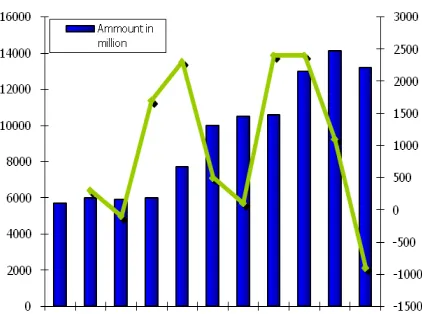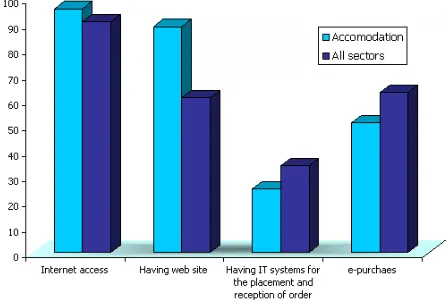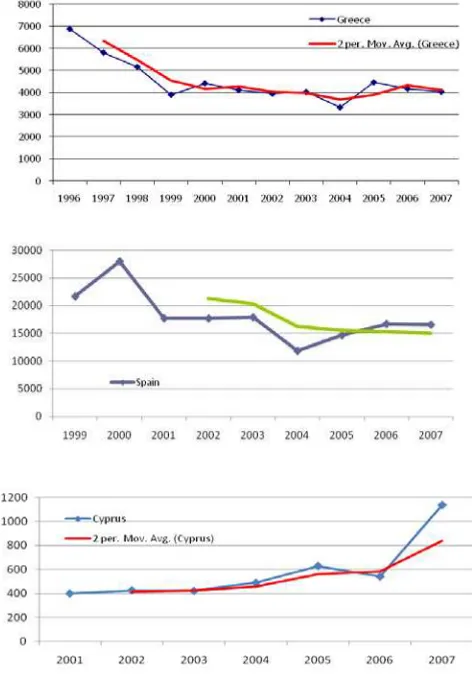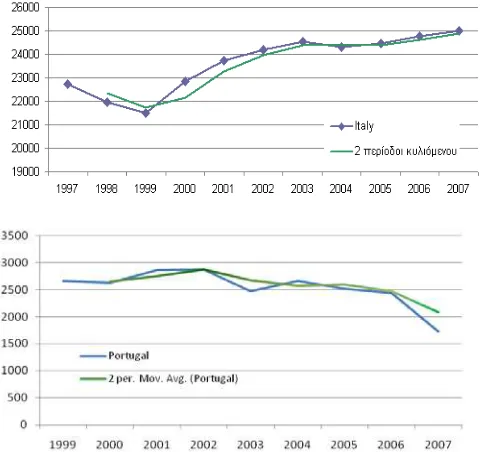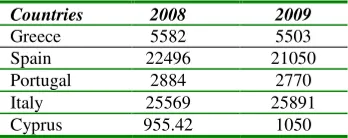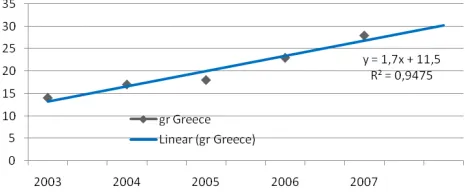Forecasting the Growth of e-Tourism
Sector: The Case Study of
Mediterranean Countries
Mavri, Maria and Angelis, Vasilis
University of the Aegean, University of the Aegean
6 July 2009
Online at
https://mpra.ub.uni-muenchen.de/25439/
FORECASTING THE GROWTH OF E - TOURISM
SECTOR: THE CASE STUDY OF MEDITERRANEAN
COUNTRIES
Maria Mavri1
University of the Aegean
Vasilis Angelis
University of the Aegean
Tourism is one of the first services sectors to adapt and use Information and Communication Technology (ICT) for promoting its services. ICT enable travelers to access reliable and accurate information, as well as to make reservations in a fraction of the time and the cost. The objective of this work is to measure the impact of ICT on the tourism sector growth. Assuming that the increase of e-tourism sector depends on the increase in e-tourism demand and internet penetration, we examine the case of all Mediterranean EU member countries, and forecast the growth of online tourism services.
Keywords: e-Tourism, ICT, forecasting techniques
INTRODUCTION
Tourism sector is one of the first services sectors to adapt and use information and communication technology (ICT) for promoting its services. Nowadays, ICT has deeply affected the way business is performed and organizations compete (Porter, 2001). Traditionally, the travel distribution role has been performed by outbound travel agencies, tour operators (TOs) and inbound travel agents or handling agencies (Buhalis & Laws, 2001). However, Internet and electronic Commerce developments in the late 1990s and the emergence of Tourism as one of the prime Business to Business (B2B) and Business to Consumers (B2C) applications has changed the situation rapidly (O’Connor, 1999; Smith et al., 1998). Internet has become a major tool and one that is widely used by the tourism sector. ICT enable travelers to access reliable and accurate information as well as to make reservations in a fraction of the time, cost and inconvenience required by conventional methods (O’Connor, 1999).
Tourism is usually defined as services for people travelling to and staying outside their usual environment for less than one consecutive year for leisure or for business purposes. Tourism involves transport, accommodation, restaurants, cultural activities and leisure and could be more effectively viewed and evaluated as a market rather than an industry. By definition “e-tourism is the use of new technologies for activities such as on line booking (hotels, tickets, etc.), portals of touristic destinations that contain information valuable for travelers, etc. What differentiates “e-tourism” from classical tourism is the large scale savings on traditional activities, such as call centers and information centers. In other words, e-tourism offers the potential to make information and booking facilities available to large numbers of consumers at arelatively low cost.
According to e-business w@tch report (2003), the world tourism industry has certainly been one of the first to make large-scale use of the new information technologies. It appears that technological progress over the past thirty years has allowed the most innovative tourism enterprises to redefine not only their own organisational structure but their relationships with partner organisations, thus achieving the twin goals of optimising operating costs and increasing ability to generate value for their customers.
Three main innovation waves had a great impact on the tourism sector in recent decades:
• the development of the Computer Reservation System (CRS) in the 70s;
• the development of the Global Distribution System (GDS) in the 80s;
• Internet in the 90s.
The big tourist organisations quickly implemented Internet strategies and set up their own Internet business areas or, in some cases, specific divisions or companies. More specifically, tourism enterprises have realised that Internet acts as an enabler that empowers organisations to achieve their objectives. However, the strategic and efficient implementation of technology within a business can reduce operational costs and support the delivery of better products or services to customers. If managed properly ICT help tourism companies and destinations to gain competitive advantage by either maintaining their price leadership in the market or by differentiating their product and services. (Poon, 1993; Werthner & Klein, 1999; Xiaoqiu Ma, J,et.al, 2003).
online room reservations, online purchasing (Morrison, et.al, 2001).In other words, Internet enables consumers to engage directly with suppliers and challeng the role of intermediaries. It also allows consumers to interact dynamically with suppliers and destinations and often make requests that will enable them to customise their products. (Jeong, et.al., 2003).
The goal of this study is to measure the growth of e-tourism sector. Assuming that the increase of this sector depends on tourism demand and on the percentage of internet users, we analyze data concerning the
number of tourists and internet users in five Mediterranean countries (Spain, Portugal, Italy, Greece and Cyprus) from the period 1996-2007. Using forecasting techniques we estimate the increase of tourism demand and internet penetration that gives an overall estimation for e-tourism increase in these countries for the next two years.
The remainder of this paper is organized as follows: Section 2 gives a brief overview of e-tourism sector in European Union; section 3 describes forecasting techniques used in literature for estimating tourism, while Section 4 presents the case study of the five Mediterranean countries. Section 5 summarizes the main conclusions and makes suggestions for further research.
e-TOURISM TODAY
Tourism is a major source of revenue in the Mediterranean countries. The following figure (Figure 1) presents the expenditures on travel in the 5 Mediterranean counties listed above. according to Tourism Panorama Guide (2007)
• Greece is one of the most popular tourism destinations in Europe, especially for beach tourism.
• Spain is one of the main tourism destinations in the world and is the best performer within the EU-27. It is also growing as a country of origin of international tourism. Outbound tourism flows show an increasing trend, resulting from the country’s economic prosperity
• Italy like Spain, is traditionally one of the main destinations for tourism in both Europe and the world.
• Cyprus, due to its geographical location and characteristics, is mainly a destination for international tourism.
Figure 1. Amount in € million
According to Eurostat’s newsletter concerning the use of ICT in tourism sector (Statistics in Focus, 34/2005), the e-Economy has thus brought many changes to the structure and to the organization of tourism markets. A new business profile has emerged, based on increased competition, and new ways of buying and selling. Some features of this new business profile of the tourism sector compared to the wider economy will be illustrated by the following figures.
1. The use of ICT in enterprises of tourism accommodation, which offer services such as access to catalogues and prices, is 63%, higher as compared to only 28% for all enterprises.
2. Services related to travel and accommodation is one of the most frequent internet activities as 47% of all internet users have used such services in the three months prior to the survey.
3. The ratio of internet users using services related to travel and accommodation increases from 7% to 47% of internet users according to educational attainment level.
4. The ratio of tourist enterprises using IT systems (i.e. orders, purchases) is 26% lower than the ratio among all enterprises which is 34%.
enterprises that use Internet express the small number of electronic tourist services that are offered.
Figure 2. Enterprises using ICT
FORECASTING TECHNIQUES
Tourism demand is an issue under examination in many research papers. According to Witt, et al., (1995), the majority of articles on tourism demand forecasting, are econometric studies. Other quantitative forecasting techniques which have actually been used in tourism include spatial models (particularly gravity models) and time-series models. One of the main findings of their study, with respect to econometric models, is that it is not possible to build a single model which is appropriate for all origin-destination pairs. Certain explanatory variables influence tourism demand for some origin-destination pairs but not others, and the estimated coefficients also vary considerably across tourist flows.
Starting from a day-to-day model on hotel specific guest nights they obtain an integer-valued moving average model by cross-sectional and temporal aggregation. The results indicate strong seasonal patterns in both mean check-in check-out probability.
Price and income are identified as key variables in forecasting tourist demand in many studies. Antonio Garcfa-Ferrer & Ricardo A. Queralt used these two variables in developing a forecasting model for tourism demand in Spain (1997).They found that the contribution of these two variable in terms of fitting and forecasting is nil. They also concluded that when dealing with medium and long-term forecasting comparisons, predicted annual growth rates may be a better alternative than traditional aggregate accuracy measures like MAPE.
According to our knowledge forecasting techniques have been rarely used in literature until recently for estimating e-tourism increase. In this paper we use classical quantitative methods in order to estimate tourism demand and Internet penetration, that leads to a conclusion related to e-tourism sector’s growth.
.
THE CASE STUDY OF MEDITERRANEAN COUNTRIES
Methodology
The data used for this study has been drawn from Eurostat databases. They are collected according to Council Directive (the “Tourism Directive”) on the collection of statistical information in the field of tourism. The data cover the period from 1996 to 2007 and include information for the five Mediterranean counties under consideration.
The scope of this paper is to explore the drivers of electronic delivery in tourism and specifically to determine the growth of e-tourism sector in five Mediterranean countries the last decade. The steps followed described below:
(a) Analyze primary data concerning tourism demand from 1996-2007 into their components, trend and cyclical component.
(b) Apply forecasting techniques to estimate the demand for the next two periods, 2008 and 2009.
(c) Analyze data concerning Internet penetration and forecast this penetration for the next two years.
while the curve expresses the trend which has been estimated using moving average techniques.
By looking at these graphs, we can make the following observations concerning the trend and the cyclical component:
• Italy and Cyprus, show an increasing trend in tourism demand • Spain and Greece show a slightly decreasing trend
• Portugal is the only country where the demand seems unchangeable during the period under examination.
• In all cases the cyclical component of demand is almost negligible.
[image:9.420.89.329.78.304.2]Based on the above, we can use the moving average technique to estimate tourism demand for the next two years. The results are shown in Table 1.
Table 1. Forecasting tourism demand
Countries 2008 2009
Greece 5582 5503 Spain 22496 21050 Portugal 2884 2770 Italy 25569 25891 Cyprus 955.42 1050
[image:10.420.81.342.268.372.2]The following table summarizes Internet penetration (the percentage of individuals who accessed Internet, on average at least once a week), and the percentage of Internet users and of the total population that use Internet for travel info & accommodation booking for the five Mediterranean countries from year 2003 to2007.
Table 2. Internet and Tourism
Countries pulation nternet Users
of Internet users hat use Internet for Travel info& Accommodation
% of popoulation hat use Internet for Travel info& Accommodation
Greece 772,816 35.2 10.3% 3.6, Spain 491,051 63.2 9.8 6.2 Italy 145.321 57 10 5.7
Cyprus 92,604 48 11.4 5.4
Portugal 676,910 73 9.1 6 .6
The above data expresses the contribution of Internet to the tourism sector growth and specifically to the e-tourism increase in Mediterranean countries. These data imply that an increase in Internet penetration would lead to a respective growth to e-tourism sector. It is obvious that only a leap in Internet penetration in these countries may change the present situation. However, predictions concerning Internet adoption and use in these countries are not optimistic.
122
Internet penetration leading to a conservative increase in using online tourism services.
CONCLUSION
This study focuses on the uptake and impacts of electronic delivery in travel and tourism services, which include passenger transport services and accommodation. We started by analyzing the current situation in the tourism sector and we concluded that the number of tourists in the five Mediterranean countries has slightly increased over the last decade. Following that, we looked at the use of online tourism services by Internet users. The analysis showed that internet users have quite adopted online search and use of online reservation systems. Looking for and booking airline ticketing and hotel reservations are among the most widely used Internet applications. Assuming that the increase in tourism demand and in Internet penetration signifies an increase of e-tourism sector, we used forecasting techniques in order to estimate the change of tourism demand and Internet penetration for the next two years. Predictions show that no significant leap neither in Internet penetration nor tourism demand can be expected for the next two years.
Since findings are very interesting, further research is required to support and verify them. Areas of further research may include
• Re-estimation of Internet penetration by calculating the number of DSL connections
• Consideration of Internet users’ personality
REFERENCES
Brannas, K., Hellstrom, J. & Nordstrom, J. (2002). A new approach to modelling and forecasting monthly guest nights in hotels. International Journal of Forecasting, Vol. 18, pp.19-30
Buhalis, D. & Laws, E. (2001). Tourism distribution channels. London, Continuum.
Garcfa-Ferrer, A. & Queralt, A.R. (1997). A note on forecasting international tourism demand in Spain. International Journal of Forecasting, Vol. 13, pp.539-549.
Jeong, M., Oh, H. & Gregoire, M. (2003). Conceptualizing Web site quality and its consequences in the lodging industry. International Journal of Hospitality Management, Vol. 22, No.2, pp.161-175.
Morrison, A.M., Jing, S., O’Leary, J.T. & Lipping, A.C. (2001). Predicting usage of the Internet for travel bookings: An exploratory study. Information Technology & Tourism, Vol. 4, No.1, pp.15-30.
O’Connor, P. & Frew, A. (2000). Evaluating electronic channels of distribution in the hotel sector: A Delphi study. Information Technology and Tourism, Vol. 3, No.3/4, pp.177-193.
Poon, A. (1993). Tourism, technology and competitive strategies. Oxford, CABI. Porter, M. & Millar, V. (1985). How information gives you competitive
advantage. Harvard Business Review, Vol. 63, No.4, pp.149-160.
Porter, M. (2001). Strategy and the internet. Harvard Business Review, Vol. 79, No.3, pp.63-78.
Smith, C. & Jenner, P. (1998). Tourism and the Internet. Travel and Tourism Analyst, Vol. 1, pp. 62-81.
Werthner, H. & Klein, S. (1999). Information technology and tourism-a challenging relationship. Austria, Springer-Verlag.
Witt, F.S. & Witt, A.C. (1995). Forecasting tourism demand: A review of empirical research. International Journal of Forecasting, Vol. 11, pp.447-475.
Xiaoqiu Ma, J., Buhalis, D. & Song, H. (2003). ICTs and Internet adoption in China’s tourism industry. International Journal of Information Management, Vol. 23, pp.451-467.
SUBMITTED: JUNE 2009
REVISION SUBMITTED: AUGUST 2009 ACCEPTED: SEPTEMBER 2009 REFEREED ANONYMOUSLY
Maria Mavri (m.mavri@ba.aegean.gr) is a Lecturer of Quantitative Methods in the School of Business, Department of Business Administration, University of the Aegean, Chios, Greece.
